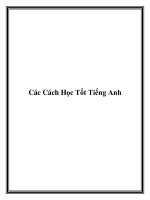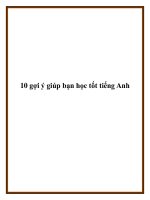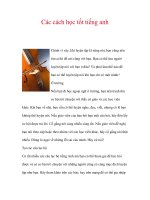Tiếng anh chuyên ngành kế toán part 3
Bạn đang xem bản rút gọn của tài liệu. Xem và tải ngay bản đầy đủ của tài liệu tại đây (105.66 KB, 10 trang )
8
Understanding the Numbers
Nutrivite
Projected Balance Sheet as of December 31, 200X
Assets Liabilities and Equity
Cash $ 40,600 Accounts payable $ 40,000
Inventory 80,000
Current assets 120,600 Current liabilities 40,000
Fixed assets: Equity:
Equipment $36,000 Capital: Jan 1 100,000
Less depreciation 3,600 Add net income 84,000
Net equipment $32,400 32,400 Less drawings (71,000)
Capital: Dec 31 113,000
Total assets $153,000 Liabilities and equity $153,000
As you can see, Cash is increased by $5,000 to $40,600—which is suffi-
cient to pay the Accounts Payable of $40,000. Drawings is decreased by
$5,000 to $71,000, which provided the $5,000 increase in Cash.
Pat: Thanks. That makes sense. I really appreciate everything you’ve taught
me about financial statements.
Kim: I’m happy to help. But there is one more financial statement to discuss.
Besides the balance sheet and income statement, a full set of financial state-
ments also includes a cash flow statement. Here is the projected cash flow
statement:
Nutrivite
Projected Cash Flow Statement for the
Year Ending December 31, 200X
Sources of Cash
From Operations:
Net income $ 84,000
Add depreciation 3,600
Add increase in current liabilities 40,000
Total cash from operations (a) $ 127,600
From Financing:
Drawings $ (71,000) Negative cash
Bank loan repaid (40,000) Negative cash
Net cash from financing (b) (111,000) Negative cash
Total sources of cash (a + b) $ 16,600
Using Financial Statements
9
Uses of Cash
Total uses of cash 0
Total sources less total uses of cash $ 16,600 Net cash increase
Add cash at beginning of year 24,000
Cash at end of year $ 40,600
Pat, do you have any questions about this Cash Flow Statement?
Pat: Actually, it makes sense to me. I realize that there are only two sources
that a business can tap in order to generate cash: internal (by earning in-
come) and external (by obtaining cash from outside sources, such as bank
loans). In our case the internal sources of cash are represented by the “Cash
from Operations” section of the Cash Flow Statement, and the external
sources are represented by the “Cash from Financing” section. It happens
that the “Cash from Financing” is negative because no additional outside fi-
nancing is received for the year 200X, but cash payments are incurred for
Drawings and for repayment of the Bank Loan. I also understand that there
are no “Uses of Cash” because no extra Equipment was acquired. In addi-
tion, I can see that the Total Sources of Cash less the Total Uses of Cash
must equal the Increase in Cash, which in turn is the Cash at the end of the
year less the Cash at the beginning of the year. But I am puzzled by the
“Cash from Operations” section of the Cash Flow Statement. I can under-
stand that earning income produces Cash. However why do we add back De-
preciation to the Net Income in order to calculate Cash from Operations?
Kim: This can be confusing, so let me explain. Certainly Net Income increases
Cash, but first an adjustment has to be made in order to convert Net Income
to a cash basis. Depreciation was deducted as an expense in figuring Net In-
come. So adding back depreciation to Net Income just reverses the charge
for depreciation expense. We back it out because depreciation is not a cash
outflow. Remember that depreciation represents just one year’s use of the
Equipment. The cash outflow for purchasing the Equipment was incurred
back when the Equipment was first acquired and amounted to $36,000. The
Equipment cost of $36,000 is spread out over the 10-year life of the Equip-
ment at the rate of $3,600 per year, which we call Depreciation expense. So
it would be double counting to recognize the $36,000 cash outflow for the
Equipment when it was originally acquired and then to recognize it a second
time when it shows up as Depreciation expense. We do not write a check to
pay for Depreciation each year, because it is not a cash outflow.
Pat: Thanks. Now I understand that Depreciation is not a cash outf low. But I
don’t see why we also added back the Increase in Current Liabilities to the
Net Income to calculate Cash from Operations. Can you explain that?
Kim: Of course. The increase in Current Liabilities is caused by an increase in
Accounts Payable. These Accounts Payable are amounts owed to our suppliers
10
Understanding the Numbers
for our purchases of goods for resale in our business. Purchasing goods for
resale from our suppliers on credit is not a cash outflow. The cash outflow
only occurs when the goods are actually paid for by writing out checks to our
suppliers. That is why we added back the Increase in Current Liabilities to
the Net Income in order to calculate Cash from Operations. In the future,
the Increase in Current Liabilities will, in fact, be paid in cash. But that will
take place in the future and is not a cash outf low in this year. Going back to
the Cash Flow Statement, notice that it ties in neatly with our balance sheet
amount for Cash. It shows how the Cash at the beginning of the year plus the
Net Cash Increase equals the Cash at the end of the year.
Pat: Now I get it. Am I right that you are going to review my projections and
then I’ll hear from you about my loan application?
Kim: Yes, I’ll be back to you in a few days. By the way, would you like a print-
out of the projected financial statements to take with you?
Pat: Yes, please. I really appreciate your putting them together and explaining
them to me. I picked up some financial skills that will be very useful to me
as an aspiring entrepreneur.
POINTS TO REMEMBER ABOUT
FINANCIAL STATEMENTS
When Pat arrived home, she carefully reviewed the projected financial state-
ments, then made notes about what she had learned.
1.
The basic form of the balance sheet is Assets = Liabilities + Owner Equity.
2. Assets are the expenditures made for items, such as Inventory and Equip-
ment, that are needed to operate the business. The Liabilities and Owner
Equity reflect the funds that financed the expenditures for the Assets.
3. Balance sheets show the financial position of a business at a given mo-
ment in time.
4. Balance sheets change as transactions are recorded.
5. Every transaction is an exchange, and both sides of each transaction are
recorded. For example, when a company obtains a bank loan, there is an
increase in the asset cash that is matched by an increase in a liability enti-
tled “Bank Loan.” When the loan is repaid, there is a decrease in cash
which is matched by a decrease in the Bank Loan liability. After every
transaction, the balance sheet stays in balance.
6. Income increases Owner Equity, and Drawings decrease Owner Equity.
7. The income statement shows how income for the period was earned.
8. The basic form of the income statement is:
a. Sales − Cost of Goods Sold = Gross Income.
b. Gross Income − Expenses = Net Income.
Using Financial Statements
11
9. The income statement is simply a detailed explanation of the increase in
Owner Equity represented by Net Income. It shows how the Owner Eq-
uity increased from the beginning of the year to the end of the year be-
cause of the Net Income.
10. Net Income contributes to Cash from Operations after it has been ad-
justed to a cash basis.
11. Not all expenses are cash outf lows—for instance, Depreciation.
12. Changes in Current Assets (except Cash) and Current Liabilities are not
cash outflows nor inflows in the period under consideration. They repre-
sent future, not present, cash flows.
13. Cash can be generated internally by operations or externally from sources
such as lenders or equity investors.
14. The Cash Flow Statement is simply a detailed explanation of how cash at
the start developed into cash at the end by virtue of cash inflows, gener-
ated internally and externally, less cash outf lows.
15. As previously noted:
a. The Income Statement is an elaboration of the change in Owner Eq-
uity in the Balance Sheet caused by earning income.
b. The Cash Flow Statement is an elaboration of the Balance-Sheet
change in beginning and ending Cash.
Therefore, all three financial statements are interrelated or, to use the
technical term, “articulated.” They are mutually consistent, and that is
why they are referred to as a “set” of financial statements. The three-
piece set consists of a balance sheet, income statement, and cash flow
statement.
16. A set of financial statements can convey much valuable information about
the enterprise to anyone who knows how to analyze them. This informa-
tion goes to the core of the organization’s business strategy and the effec-
tiveness of its management.
While Pat was making her notes, Kim was carefully analyzing the Nutriv-
ite projected financial statements in order to make her recommendation to the
bank’s loan committee about Nutrivite’s loan application. She paid special at-
tention to the Cash Flow Statement, keeping handy the bank’s guidelines on
cash flow analysis, which included the following issues:
• Is cash from operations positive? Is it growing over time? Is it keeping
pace with growth in sales? If not, why not?
• Are cash withdrawals by owners only a small portion of cash from opera-
tions? If owners’ cash withdrawals are a large share of cash from opera-
tions, then the business is conceivably being milked of cash and may not
be able to finance its future growth.
12
Understanding the Numbers
• Of the total sources of cash, how much is being internally generated by
operations versus obtained from outside sources? Normally wise busi-
nesses rely more on internally generated cash for growth than on external
financing.
• Of the outside financing, how much is derived from equity investors and
how much is borrowed? Normally, a business should rely more on equity
than debt financing.
• What kind of assets is the company acquiring with the cash being ex-
pended? Are these asset expenditures likely to be profitable? How long
will it take for these assets to repay their cost and then to earn a reason-
able return?
Kim reflected carefully on these issues and then finalized her recommen-
dation, which was to approve the loan. The bank’s loan committee accepted
Kim’s recommendation and even went further. They authorized Kim to tell Pat
that—if she met all her responsibilities in regard to the loan throughout the
year—the bank would renew the loan at the end of the year and even increase
the amount. Kim called Pat with the good news. Their conversation included
the following dialogue:
Kim: To renew the loan, the bank will ask you for new projected financial
statements for the subsequent year. Also, the loan agreement will require
you to submit financial statements for the year just past—that is, not pro-
jected but actual financial statements. The bank will require that these ac-
tual financial statements be reviewed by an independent CPA before you
submit them.
Pat: Let me be sure I understand: Projected financial statements are forward-
looking, whereas actual financial statements are backward looking, is that
correct?
Kim: Yes, that’s right.
Pat: Next, what is an independent CPA?
Kim: As you probably know, a CPA is a certified public accountant, a profes-
sional trained in finance and accounting and licensed by the state. Indepen-
dent means a CPA who is not an employee of yours or a relative. It means
someone in public practice in a CPA firm, someone who will likely make an
objective and unbiased evaluation of your financial statements.
Pat: And what does reviewed mean?
Kim: Good question. CPAs offer three levels of service relating to financial
statements:
• An audit is a thorough, in-depth examination of the financial statements
and test of the supporting records. The result is an audit report, which
states whether the financial statements are free of material misstate-
ments (whether caused by error or fraud). A “clean” audit report pro-
vides assurance that the financial statements are free of material
misstatements. A “modified” report gives no such assurance and is cause









